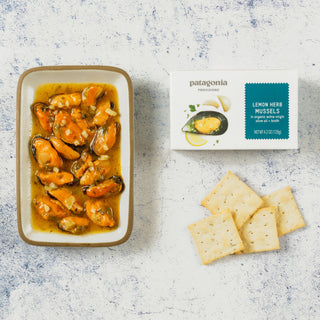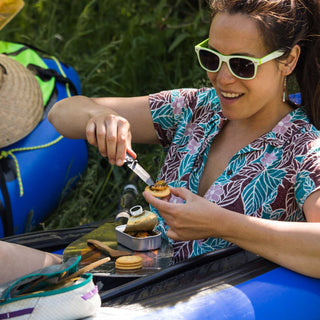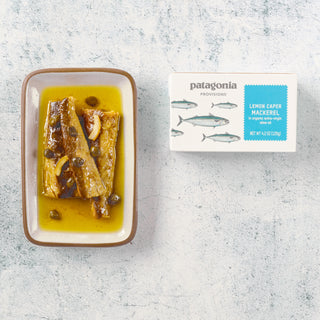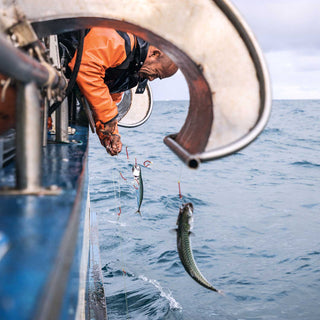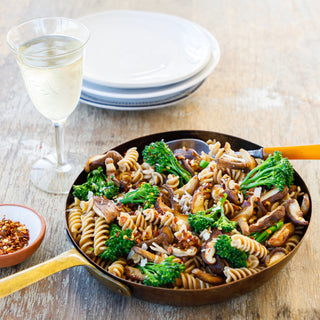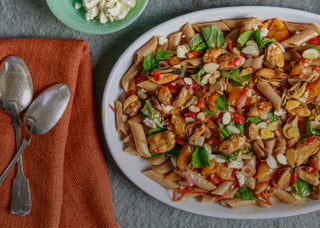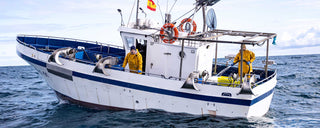My Friend Nancy was not impressed. I was on one of my semiannual visits to Madrid, only this time, instead of meeting her at our usual tapas bar for a glistening plate of ruby-colored jamón ibérico or deliciously sweet and briny grilled prawns, I had insisted on meeting in this new, overly bright bar where the table next to us was too loud, the music ran to cheesy Spanish pop, and where the server, per my request, had just plunked down some thick slices of bread topped with chunks of oily Atlantic mackerel. Nancy looked at the plate skeptically. “This is what you wanted to eat?” she asked. “Canned fish?” I understood her doubt, because I used to feel it myself: canned mackerel had always struck me as too salty, unpleasantly fishy and kind of dry, despite all the oil it swam in. But that was before my conserva conversion.
You could say it started in Vilanova de Arousa, in Galicia, on the northwestern coast of Spain. If you drive through this town with the windows up, you barely notice the place. Positioned on the Arousa bay, it has a museum devoted to homegrown author Ramón María del Valle-Inclán, a decent seaside promenade, and a bunch of drab, blocky factories. But descend from the car, and Vilanova de Arousa’s most distinctive feature makes itself immediately clear. Emanating from those factories, and wafting over the town like a cloud of perfume, is the alluring scent of fried garlic, vinegar and seafood.
Like other towns on the Galician coast, Vilanova de Arousa is a bastion of conservas. The Spanish word encompasses anything in a can, but here in Galicia, where fishing is not just the main economic activity but practically a religion, it refers to the tinned seafood—everything from razor clams to tuna—that are a staple of the Spanish diet: a taste of the sea brought to inland regions far from the water, or, slapped into a baguette, the source of a quick, humble meal.
 Photo by Amy Kumler
Photo by Amy Kumler
Lately, the tried and true conserva has undergone some changes. Some of that is due to the emergence of retro-chic tapas bars, like the one in Madrid, that serve nothing but preserved foods. But some of it is also thanks to the efforts of a company like Conservas Antonio Pérez Lafuente. In 2005, it became the first producer of canned seafood to convert to sustainable fishing, bringing conservas into the modern age and redefining the notion of quality. It certainly redefined how I felt about mackerel. “We were the pioneers in Spain,” says the company’s CEO, Juan Pérez Lafuente, who is also the grandson of its founder. “At the time, no one even knew what sustainable fishing meant. But one of the things we learned is that it means only working with certain species. And this means mackerel.”
Behind that decision lies a couple of centuries of Spanish history, to say nothing of global economic changes. Preserved fish first became an industry in Spain in the 1800s, and Galicia, with its strong fishing heritage, became its hub. At first, the region specialized in salazones—a simple preservation method that uses just salt and sunshine to dry fish—but gradually, technological advances made canning an important technique as well. Juan’s great-great-grandfather took advantage of the new knowledge, and then diversified his offerings to include conservas.
By the time his children were grown, conservas were doing well enough that, following a fight with his siblings, Juan’s grandfather Antonio could split off that part of the business and strike out on his own. “The rest of the family,” Juan says, "got the salazones."
“We saw a niche. But it meant we had to come up with a whole new system.”
— Juan Pérez Lafuente
Antonio’s timing was impeccable. Spain stayed neutral during the First World War, which meant that Galicia’s canneries, located far from the front, remained intact while much of the rest of Europe lay in ruins. Throughout the 20th century, the industry continued to grow. “In the ‘50s and ‘60s, the whole town lived off fishing and canning,” says Juan. “There was a siren in the town hall, and on the days when there was a catch, they would sound it so that people would know to go to the canneries.”
These days, the siren only rings on special occasions. Even though fishing and canning are still the main industries in town, lots of people have moved to larger cities. And, as mechanization gradually transformed an artisanal enterprise into an industrial one, big companies began buying up the old family workshops. The roughly 500 conserva businesses that lined the Galician coast in the 1970s were down to 100 by the 1990s. “Now,” says Juan, “it’s 40 or 50.”
When his father died at the beginning of this century, he faced a decision. “I didn’t want to sell out. But our traditional clients were disappearing. The conserva shops were disappearing. How could we ensure that this family business survives?” The answer was an innovation that for tradition-bound Galicia seemed so daring as to be foolhardy: He opted to convert to sustainable fishing and organic production.
At the time, awareness about the fragility of stocks was growing, as the European Union began imposing smaller quotas and even outright moratoria on the fishing of vulnerable species. The Prestige oil spill in 2002, which devastated much of the Galician coastline, only increased this awareness. At the same time, a fledgling export relationship with Germany, Europe’s largest consumer of organic and sustainable products, convinced him there was an opportunity to do things differently. “We saw a niche,” Juan says now. “In some ways, it would mean doing what we had always done, which was to work with local products and prepare them artisanally, with great care. But it also meant we had to come up with a whole new system. We had to develop our own criteria.”
Meetings with organizations like Greenpeace and World Wildlife Federation helped Conservas Antonio Pérez Lafuente develop its new protocols. A first step entailed restricting their production to species whose sustainability could be guaranteed. Mussels, which are cultivated in Galicia and actually help purify water through their filtering mechanism, were an obvious choice. Atlantic mackerel was another.
Atlantic mackerel (Scomber scombrus) is a pelagic—or deep-water—species that lives primarily off zooplankton like fish larvae and tiny crustaceans, and is distinct from Spanish and King mackerel. Because it eats low on the food chain, the fish leaves less of a “footprint” on other aquatic species; in comparison, a top predator like Atlantic bluefin tuna can collectively consume as much as 30 percent of that sea’s herring stock in a year. Even farmed fish like salmon can require as much as five pounds of edible fish, ground into fishmeal, to gain every pound for their own bodies. “Eating lower on the food chain means there are more fish in the sea,” says Christien Absil, director and fisheries expert of the Good Fish Foundation, a Netherlands-based organization that evaluates the sustainability of Europe’s seafood sector. “It also means that the fish you’re eating has accumulated less mercury, dioxins, and other hazardous substances.”
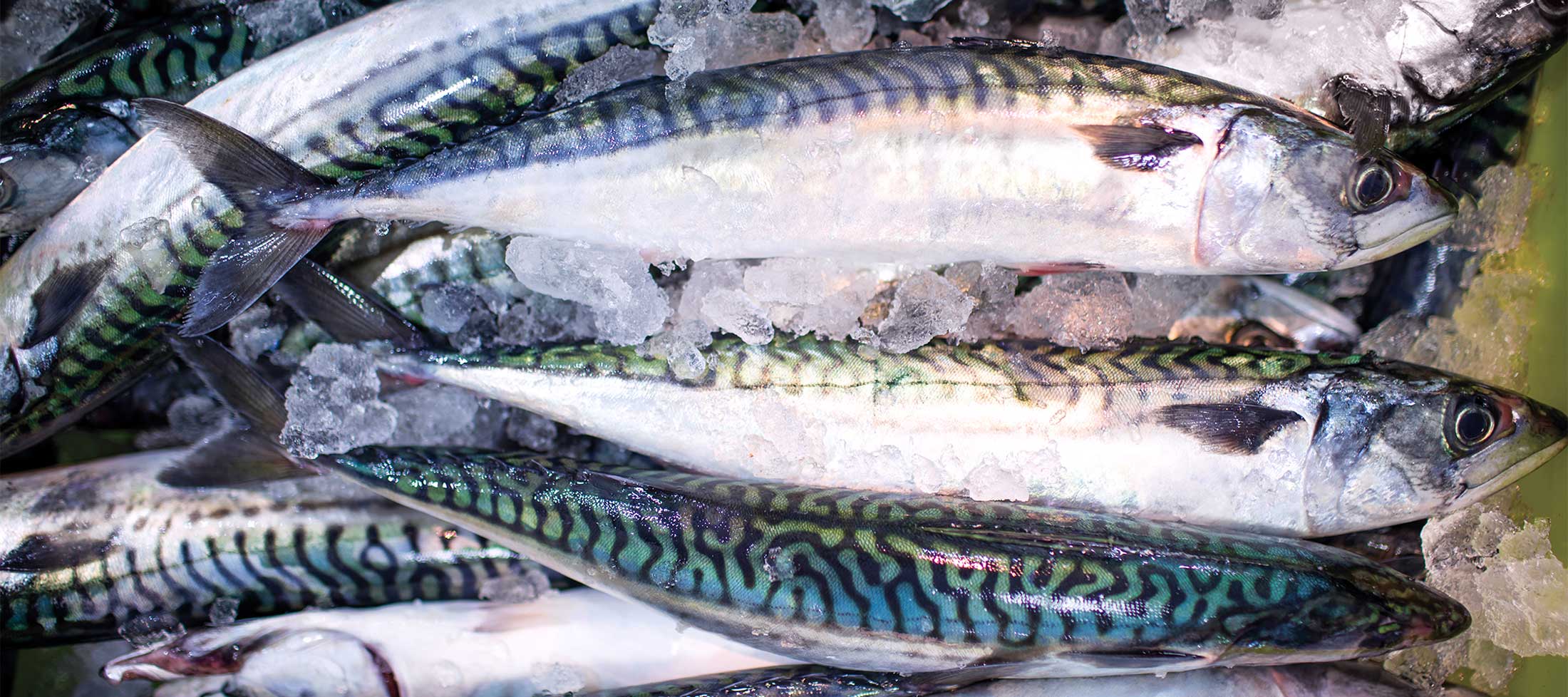 Photo by Amy Kumler
Photo by Amy Kumler
Atlantic mackerel is also abundant. “Unlike cod, there’s only one stock,” says Absil. “And it keeps expanding, even in areas where it wasn’t available before, like Iceland. We’re not quite sure why; it may have to do with climate change. The good thing is that it means the stock can withstand extra pressure.”
Part of that resilience comes from how the mackerel are fished, which is where José Ramon Fernández del Val, or Jota, as he’s known, comes in. In addition to running his own cannery, Jota is the seafood buyer for Lafuente, and the Atlantic mackerel he sources comes from a particularly responsible fishery in Cantabria, a few hours east of Galicia.
 Photo by Amy Kumler
Photo by Amy Kumler
Wedged into a curve on the Bay of Biscay, the Cantabrian town of Santoña is a fishing town famous for producing the best anchovies in Spain (or, according to locals, the world). But mackerel are also fished there, for as they migrate south they school prolifically in its waters, usually between late March and late May. During that time, the European Union regulates the total that can be caught (the amount changes yearly), as well as their size (the fish must be more 7.1 inches long) and age (2 years or older).
Equally important is the method by which the mackerel are caught in Santoña. “All the fishing here is artisanal— these are families, not big corporations— and they’re all members of the cofradía,” Jota explains. Cofradias are organizations with medieval roots that today act as both unions and social institutions, with their own bars and festivals. “And the cofradía only fishes with anzuelo.”
 Photo by Amy Kumler
Photo by Amy Kumler
Anzuelos are individual lines with up to 30 hooks wrapped with red wool, which resemble the tiny crustaceans mackerels love—meaning live bait isn’t necessary. Because the schools of mackerel are so large, and because each fish must bite the line to be caught, the anzuelo ensures that there isn’t a lot of bycatch, unlike with trawlers or purse seine nets. “You’re not catching anything by mistake,” says Jota. “The nets scoop up everything—sometimes 80 tons a day. But anzuelo treats the species with respect and control. It’s not possible to kill off a species this way.” The anzuelo also ensures better quality, he says. “With big nets, the fish on the bottom get crushed. That doesn’t happen with the lines. There’s simply no better way of fishing.”
 Photo by Amy Kumler
Photo by Amy Kumler
In Santoña, tiny boats go out at five or six in the morning, sailing through the choppy waters until they come upon one of the massive schools of fish. Once they unfurl the anzuelos, it doesn’t take long before the lines are full of dozens of mackerel, repeatedly hauled aboard. The boats return to town when they’ve caught the day’s supply. Unloaded at the dock, the fish are immediately auctioned, which is where Jota first encounters them. After he’s made his purchase, the fish are packed on ice and loaded onto trucks bound for Vilanova de Arousa. The time between harvest and arrival at Lafuente can be as little as half a day.
The emphasis on sustainability—both environmental and social—doesn’t stop at the factory doors. Once cleaned and cooked, the fish are broken down into fillets and the scraps are made into fishmeal that can be used in aquaculture, so that nothing goes to waste. The fillets are then packed in tins according to one of the company’s 70 recipes, sealed and sterilized. All of that work is done by one of the 30 or so women employed by the Lafuente company. “In Galicia, historically, this has always been women’s work,” says Mónica Silva, who oversees quality control. “Maybe we’ll modernize with time, but for now, it’s all ours.”
Those women, then, have the final say in the product’s quality, and delicate treatment is key. It’s vital, says Juan, to preserve the thin layer of fat on the fish’s surface. “That’s what makes it juicy.”
Juicy, indeed. At home, I crack open a tin of the mackerel with Spanish paprika that Lafuente prepares especially for Provisions, and spoon the contents onto a slice of toasted sourdough. The spiced olive oil from the tin seeps into the bread, tinting it the brick red of good Extremaduran pimentón. I take a bite. The fish is surprisingly plump and meaty, its slight sweetness heightened by the roasted red pepper and onion. I find myself going back for another chunk.
 Photo by Thomas J. Story. Food styling by Karen Shinto
Photo by Thomas J. Story. Food styling by Karen Shinto
And I’m not the only one. A few weeks later, at that tapas bar in Madrid, I slide the plate closer to Nancy. The mackerel before us doesn’t come from Lafuente—most of their production is exported—but the fish brings just the right degree of meaty brininess to peasant bread smeared with roasted red pepper hummus. “You know what?” Nancy says in mild astonishment as she too reaches for another piece. “It’s delicious.”
And with that, another conserva convert is made.


